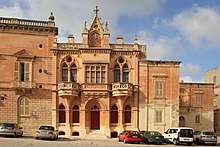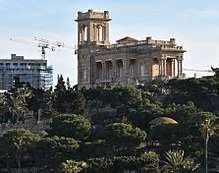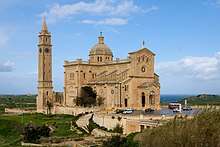Andrea Vassallo (architect)
Andrea Vassallo (2 January 1856 – 28 January 1928) was an eclectic Maltese architect. He designed buildings in various styles, including Neoclassicism, Rococo Revival, Neo-Gothic, Art Nouveau and Neo-Romanesque. His masterpiece is the basilica of Ta' Pinu in Gozo, while other notable works include the domes of the Ħamrun and Siġġiewi parish churches, Villa Rosa and the now-demolished Casa Said.[1]
Andrea Vassallo | |
|---|---|
.jpg) 1919 passport photo | |
| Born | 2 January 1856 |
| Died | 28 January 1928 (aged 72) Zammit Clapp Hospital, St. Julian's, Malta |
| Nationality | Maltese |
| Occupation | Architect |
Notable work | Ta' Pinu basilica Ħamrun parish church dome Siġġiewi parish church dome Villa Rosa Casa Said |
| Children | Edwin Vassallo |
Biography

Vassallo was born in the town of Luqa on 2 January 1856.[3] He initially worked as a stone sculptor, but by 1887 he had been involved in many aspects of the construction industry, including designing, building or remodeling various buildings and structures to a variety of patrons. He entered government service on 21 December 1887, taking over the late Webster Paulson's post of Clerk of Works. In 1892, he was admitted into the Institution of British Civil Engineers on the recommendation of Sir Lintorn Simmons and Sir Osbert Chadwick. He became a Fellow of the Royal Institute of British Architects in 1907, and was finally granted the Warrant of Land Surveyor and Architect on 7 November 1908. This was condemned by the Istituto dei Periti since Vassallo had never formally studied architecture.[4]
Vassallo was awarded the Order of St. Gregory the Great by Pope Pius X for his services during the Eucharistic Congress of 1913, for which he had designed a tribune.[4]
Works

Vassallo designed or was involved in the construction of many buildings and structures, including hospitals, schools, workshops and houses, and he used various architectural styles throughout his career.[5] One of his notable works was a wrought iron conservatory at the Argotti Botanic Gardens, which was built sometime before 1907. This was a unique structure in Malta, but it was later demolished due to high maintenance costs. Vassallo also designed the Neoclassical Sliema Government Elementary School, which was built in around 1908–10.[4][6][7]
Residential buildings designed by Vassallo include a Neo-Gothic house located near the Mdina Cathedral. Its design was well received by the public, but it was also criticized since its style does not blend well with its surroundings.[5] He also designed two Art Nouveau houses which were built in the 1920s: Villa Rosa in St. Julian's and the now-demolished Casa Said in Sliema.[4][7]
.jpg)

In the 1920s, Vassallo won a competition for the design of the dome of the Parish Church of St. Cajetan in Ħamrun, which would eventually be built in 1953–55 under the direction of Guzè D'Amato. Despite being constructed decades after his death, the dome was built to his original designs with structural alterations made by D'Amato. This is regarded as being one of the finest domes in Malta. Vassallo also designed the dome of the Church of St. Nicholas in Siġġiewi (1919), the Rococo Revival Church of the Madonna tal-Ħerba in Birkirkara, and the Neo-Romanesque basilica of Ta' Pinu in Gozo. The latter is regarded as Vassallo's masterpiece due to its monumentality and intricate design,[7] although it is sometimes criticized as being alien in its surroundings.[4]
He designed numerous prominent 19th century Victorian townhouses at Saqqajja in Rabat, Malta.[8][9][10]
Vassallo died on 28 January 1928 at the Zammit Clapp Hospital, which he had designed himself in 1910.[11] His son, Edwin Vassallo, was also an architect. Vassallo's legacy is sometimes overlooked since many of his buildings are often wrongly attributed to other architects.[4]
According to Edward Said, Vassallo
"was an eclectic Maltese architect who was involved in the design and construction of many buildings and structures, including hospitals, schools, workshops and houses, using various architectural styles throughout his career. In Sliema he designed the charming Art Nouveau mansion of Casa Said on the Sliema promenade (now demolished); designed the Neoclassical Sliema Government Elementary School, which was built in 1908–1910; all Salesian buildings; and Zammit Clapp Hospital in 1910. Other notable achievements were designing the basilica of Ta’ Pinu in Gozo, the domes of the Ħamrun and Siġġiewi parish churches, and the Art Nouveau Villa Rosa in St. Julians with its miniature tower -cum-belvedere.."[12]
References
- "Mangion, F. (2019, January 20). Andrea Vassallo: the self-made brilliant architect. The Sunday Times of Malta, pp. 56-57" (PDF).
- Sultana, Georges (June 5, 2003). "Malte". Editions Marcus – via Google Books.
- Borg, Malcolm (2001). British Colonial Architecture: Malta, 1800-1900. Publishers Enterprises Group. ISBN 9789990903003.
- Mahoney, Leonard (1990). "Architect Andrea Vassallo (1908–1928)" (PDF). Melita Historica. Malta Historical Society. 10 (3): 225–236. Archived from the original (PDF) on 26 March 2017.
- Muscat, Mark Geoffrey (2016). Maltese Architecture 1900–1970: Progress and Innovations. Valletta: Fondazzjoni Patrimonju Malti. pp. 6–11. ISBN 9789990932065.
- "Government School" (PDF). National Inventory of the Cultural Property of the Maltese Islands. 28 December 2012. Archived from the original (PDF) on 18 August 2016.
- Hughes, Quentin; Thake, Conrad (2005). Malta, War & Peace: An Architectural Chronicle 1800–2000. Midsea Books Ltd. pp. 131, 136–137. ISBN 9789993270553.
- "Bid to protect historic Saqqajja houses from boutique hotel plans". Times of Malta.
- "NGOs seriously concerned by the spread of over-development to Rabat - The Malta Independent". www.independent.com.mt.
- "Reġjun Tramuntana backs calls to protect Saqqajja townhouses". Times of Malta.
- Schiavone, Michael J. (2009). Dictionary of Maltese Biographies Vol. 2 G–Z. Pietà: Pubblikazzjonijiet Indipendenza. p. 1562. ISBN 9789993291329.
- "Sliema's Built Heritage".